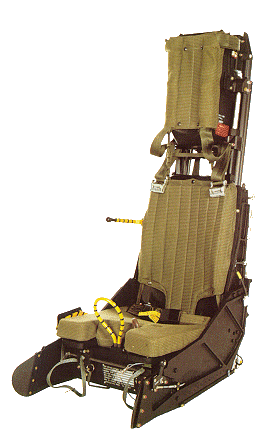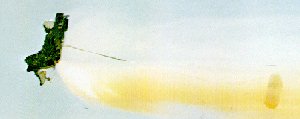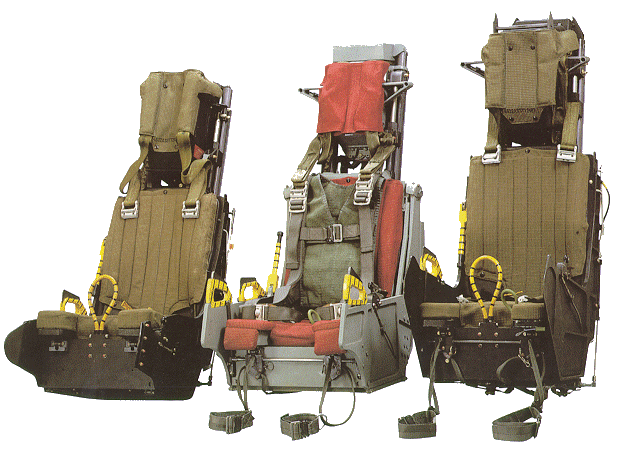The Ejection Site
The Universal Propulsion Co. SIIIS
 Originally designed and manufactured by Stencel Aero Engineering,
a subsidiary of Talley Industries, which was merged with
Universal Propulsion Inc. another
division of Talley (later sold to Goodrich), the S-III-S is used in several different military
aircraft including the AV-8B Harrier. The S-III-S seat is designated the
SJU-4/A in US Navy and Marine Corp terminology. It is rated from 0-0 to
600 kts. The seat uses a seat
bucket that can be raised and lowered on a pair of tubes (one on either
side of the bucket) which allows the headrest and most of the seat to
maintain a fixed position in the cockpit. The seat has a pair of ballistic
catapult tubes that on initiation begin initial movement of the seat. The
S-III-S uses a pair of seat back mounted rockets to provide additional
thrust and boost the seat to safe altitude in low or no speed ejections.
Originally designed and manufactured by Stencel Aero Engineering,
a subsidiary of Talley Industries, which was merged with
Universal Propulsion Inc. another
division of Talley (later sold to Goodrich), the S-III-S is used in several different military
aircraft including the AV-8B Harrier. The S-III-S seat is designated the
SJU-4/A in US Navy and Marine Corp terminology. It is rated from 0-0 to
600 kts. The seat uses a seat
bucket that can be raised and lowered on a pair of tubes (one on either
side of the bucket) which allows the headrest and most of the seat to
maintain a fixed position in the cockpit. The seat has a pair of ballistic
catapult tubes that on initiation begin initial movement of the seat. The
S-III-S uses a pair of seat back mounted rockets to provide additional
thrust and boost the seat to safe altitude in low or no speed ejections.
As with the most modern seats, the S-III-S is equipped with torso restraint
inertia reels
that are gas fired on ejection to retract the pilot to the upright position.
It is fitted with a limb restraint
system to hold the pilot's legs firmly against the seat during the first few
seconds after ejection. The limb restraint garters are attatched by lanyards
through a set or ratchet assemblies and on to the catapult manifold, which
remains in the aircraft during ejection. The result of this routing is that
as the seat rises up the catapult tubes, the pilot's legs are drawn back by
the lanyards to be held against the seat by the ratchet assemblies. The
lanyards have a rip stich point that tears free once the legs are firmly in
place.
The S-III-S is normally equipped to eject through the canopy for more rapid
response. This is accomplished in two ways. First on the Harrier, the
canopy is shattered by a line of Mild Detonating Cord (MDC) which is applied
to the canopy, and visible in most photos of the Harrier. This is fired as
part of the seat ignition and shatters the canopy enough for the pilot to
clear easily. In the RAF, there were some incidents that indicated that the
pilots may have been being injured by small fragments of the
plexiglass/acrylic canopy cutting their exposed faces, and they made it
manditory that the pilots fly with thier helmet visors down at all times to
protect their faces. Should the canopy destruct system fail, the secondary
ability of the seat is its integral canopy breakers. The four breakers are
mounted on the headrest such that the right aft breaker strikes the canopy
first, which cracks it. The left rear breaker strikes next, propagating the
breaks, and then the front pair strike to push aside enough of the
transparency for the pilot to get through uninjured.
 Seat stability is a special concern, and is controlled in two ways by the
S-III-S. One of these is the DART® system which consists of a lanyard
that is connected to the cockpit floor and plays out of a mounting system
under the seat bucket at a set deployment force. This keeps the seat from
pitching or rolling significantly while the Wind Oriented Rocket Deployment
(WORD) system begins to withdraw the drogue chute. The WORD rocket can be seen clearly in the center of this photo. Once the seat has reached
the full length of the DART bridle it disconnects and the seat continues
with the drogue stabilizing it. The DART implementation on the S-III-S
includes a fold-down panel that has aerodynamic stabilizing qualities as well.
Seat stability is a special concern, and is controlled in two ways by the
S-III-S. One of these is the DART® system which consists of a lanyard
that is connected to the cockpit floor and plays out of a mounting system
under the seat bucket at a set deployment force. This keeps the seat from
pitching or rolling significantly while the Wind Oriented Rocket Deployment
(WORD) system begins to withdraw the drogue chute. The WORD rocket can be seen clearly in the center of this photo. Once the seat has reached
the full length of the DART bridle it disconnects and the seat continues
with the drogue stabilizing it. The DART implementation on the S-III-S
includes a fold-down panel that has aerodynamic stabilizing qualities as well.
Parachute deployment is accomplished by a series of events that include the
WORD rocket firing, and launching the drogue, the headrest opening at the
preset time, and the WORD and Drogue pulling the chute lines to full
extension, whereupon a spreading charge fires the parachute skirt full open
for rapid deployment. (This only occurs in Mode 1, low and slow ejection.)
Seat separation follows with the parachute force aligning the seat/man mass
with the parachute drag vector. Once the force builds to a set point, the
seat/man separation lanyard actuates the separation system.
The separation lanyard rotates the seat panel release shaft. This bellcrank
activated shaft allows the seat pan to release from the seat bucket assembly,
and releases the leg restraint ratchet assemblies. It also activates a
gas-generator to fire a guillotine to cut the inertia reel straps. These actions
leave the crewman free of the seat structure, with the survival kit, seat pan,
and emergency oxygen system.
While I have been discussing mainly the Harrier seat, versions of the seat
have been used in such aircraft as the Alpha Jet, F-16 FSED prototypes, the
A-7 Corsair, the Argentine 1A-63, the YF-17 prototype, the Northrup F-20, the
Beech Starship, and the Scaled composite ARES.
 |
| Three different varients of the S-III-S,
Left is the SJU-4, Middle an early prototype, and right is the Escapac
Replacement (ER) SJU-8 used in the Chance/Voight A-7 Corsair II
|
 These systems often have different appearance and nomenclature although they
use the same basic systems. UPCo is looking toward the future, and they are
working on developing new and improved versions for possible use. The Stencel
S-4-S system is a prototype seat based
on the S-III-S with additional folding stabilizers and other improvements for
high speed ejection.
These systems often have different appearance and nomenclature although they
use the same basic systems. UPCo is looking toward the future, and they are
working on developing new and improved versions for possible use. The Stencel
S-4-S system is a prototype seat based
on the S-III-S with additional folding stabilizers and other improvements for
high speed ejection.
Pictures compliments of
Universal Propulsion Co, Inc, (UPCO)
Thanks to Larry Hadley, Mid-Western Regional Manager, UPCO
Additional photos of Stencel seats can be found on these pages:
 Seat stability is a special concern, and is controlled in two ways by the
S-III-S. One of these is the DART® system which consists of a lanyard
that is connected to the cockpit floor and plays out of a mounting system
under the seat bucket at a set deployment force. This keeps the seat from
pitching or rolling significantly while the Wind Oriented Rocket Deployment
(WORD) system begins to withdraw the drogue chute. The WORD rocket can be seen clearly in the center of this photo. Once the seat has reached
the full length of the DART bridle it disconnects and the seat continues
with the drogue stabilizing it. The DART implementation on the S-III-S
includes a fold-down panel that has aerodynamic stabilizing qualities as well.
Seat stability is a special concern, and is controlled in two ways by the
S-III-S. One of these is the DART® system which consists of a lanyard
that is connected to the cockpit floor and plays out of a mounting system
under the seat bucket at a set deployment force. This keeps the seat from
pitching or rolling significantly while the Wind Oriented Rocket Deployment
(WORD) system begins to withdraw the drogue chute. The WORD rocket can be seen clearly in the center of this photo. Once the seat has reached
the full length of the DART bridle it disconnects and the seat continues
with the drogue stabilizing it. The DART implementation on the S-III-S
includes a fold-down panel that has aerodynamic stabilizing qualities as well.
 Originally designed and manufactured by Stencel Aero Engineering,
a subsidiary of Talley Industries, which was merged with
Universal Propulsion Inc. another
division of Talley (later sold to Goodrich), the S-III-S is used in several different military
aircraft including the AV-8B Harrier. The S-III-S seat is designated the
SJU-4/A in US Navy and Marine Corp terminology. It is rated from 0-0 to
600 kts. The seat uses a seat
bucket that can be raised and lowered on a pair of tubes (one on either
side of the bucket) which allows the headrest and most of the seat to
maintain a fixed position in the cockpit. The seat has a pair of ballistic
catapult tubes that on initiation begin initial movement of the seat. The
S-III-S uses a pair of seat back mounted rockets to provide additional
thrust and boost the seat to safe altitude in low or no speed ejections.
Originally designed and manufactured by Stencel Aero Engineering,
a subsidiary of Talley Industries, which was merged with
Universal Propulsion Inc. another
division of Talley (later sold to Goodrich), the S-III-S is used in several different military
aircraft including the AV-8B Harrier. The S-III-S seat is designated the
SJU-4/A in US Navy and Marine Corp terminology. It is rated from 0-0 to
600 kts. The seat uses a seat
bucket that can be raised and lowered on a pair of tubes (one on either
side of the bucket) which allows the headrest and most of the seat to
maintain a fixed position in the cockpit. The seat has a pair of ballistic
catapult tubes that on initiation begin initial movement of the seat. The
S-III-S uses a pair of seat back mounted rockets to provide additional
thrust and boost the seat to safe altitude in low or no speed ejections.

 These systems often have different appearance and nomenclature although they
use the same basic systems. UPCo is looking toward the future, and they are
working on developing new and improved versions for possible use. The Stencel
S-4-S system is a prototype seat based
on the S-III-S with additional folding stabilizers and other improvements for
high speed ejection.
These systems often have different appearance and nomenclature although they
use the same basic systems. UPCo is looking toward the future, and they are
working on developing new and improved versions for possible use. The Stencel
S-4-S system is a prototype seat based
on the S-III-S with additional folding stabilizers and other improvements for
high speed ejection.